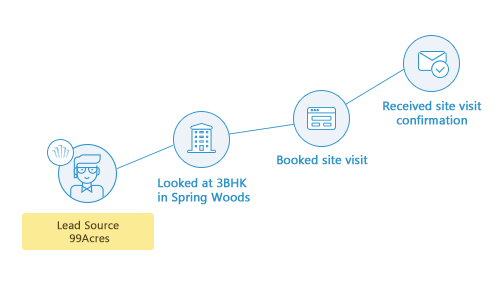Jerry owns a busy real estate agency in a big city. His business has grown exponentially over the past few years. As competition heats up and market conditions change, Jerry knows he needs more than just a great team and a strong network to stay ahead. He needs automation. He needs to make sure every part of his business is running efficiently. That’s where real estate KPIs work their way in.
The journey to optimizing his business started with working out what the critical operational Key Performance Indicators (KPIs) were for his real estate business. That would help Jerry measure and improve his operational performance. Let’s see how he did it and what worked for him. But first:
What is an Operational KPI?
Operational KPIs are numbers that give businesses a clear view of how they are running and performing. These are key to understanding how different parts of the business are working, from transaction speed to client satisfaction.
For Jerry, KPIs gave him a full view of how his real estate business was running, so he could see where he was strong and where he could improve. By looking at these indicators, he could see how his team was working, where the bottlenecks were, and how to increase productivity overall.
What are Operational KPIs in Real Estate?
The real estate market in India is expected to reach US$ 1 trillion by 2030, and will contribute 13% to the country’s GDP by 2025.
In real estate, operational KPIs focus on the key performance areas that impact daily business activities. For Jerry, these were metrics related to efficiency, sales performance, and client satisfaction. By keeping an eye on these indicators, he could measure his business’s success, identify areas for improvement, and align his strategies to his goals.
With real estate KPIs, Jerry could make data-driven decisions that were key to business growth. Instead of relying on gut feeling or anecdotal evidence, he could base his decisions on numbers, allocate leads, and improve the customer experience. This would not only help with day-to-day management, but also long-term planning and enable Jerry to build a more robust and competitive real estate business!
Why Real Estate KPIs Matter
For Jerry, tracking operational KPIs was key to navigating the real estate landscape. Here’s why real estate KPIs worked:
- Increased Efficiency: Jerry used KPIs to identify process bottlenecks, smoothen operations, and improve service delivery – which reduced delays and sped up property sales.
- More Sales: By analyzing sales performance metrics, Jerry refined his strategies, increased revenue, and improved productivity.
- Better Client Satisfaction: By monitoring client satisfaction and referral rates, Jerry was able to improve his service, build stronger relationships with clients, and get more referrals.
In short, operational KPIs for real estate allowed Jerry to make informed decisions, adapt to changes, and achieve long-term success for his real estate business.

Operational KPIs for Real Estate Businesses
Operational KPIs are key for real estate businesses as they give you measurable numbers to measure your performance. Monitoring these KPIs allows real estate businesses to identify strengths and areas for improvement, optimize their strategies, and drive overall growth and profitability.
Efficiency KPIs
1. Time on market
The KPI was key for Jerry. It measured the average number of days a property was on the market before it was sold or leased. By tracking this metric, Jerry could see how his team was managing property sales.

Steps to Calculate Time on Market:
- Date Listed: Record the date the property was listed for sale.
- Date of Sale: Record the date the property sold.
- Calculate the Difference: Subtract the Date Listed from the Date of Sale to get the number of days on market.
Less time on market meant Jerry’s strategies and pricing were working. More time on market meant problems like overpricing or poor presentation, so a re-evaluation of pricing or marketing was needed.
2. Average transaction time
Jerry also looked at the “Average Transaction Time” which measures the time from property listing to settlement. Basically, the average amount of time needed to complete a transaction, starting with the listing or inquiry and ending with the lease agreement or final closing.

Where:
- Transaction duration = the interval between each transaction’s listing and closing dates. To calculate, subtract the listing date from the closing date.
- Total Transaction Duration = The sum of all individual transaction durations.
- Number of Transactions = How many transactions are to be considered in the calculation.
Less average transaction time meant it was a well-oiled machine, with skilled negotiating and all stakeholders working together. This KPI helped Jerry identify where the process was slowing down and make changes to speed up the transaction and make it better for both buyer and seller.
“For real estate builders and property-tech companies, leads can come from various sources like website, inquiry calls, aggregators like MagicBricks and offline expos and stalls. We have seen our clients not just capture all these leads, but also manage their databases with our platform. A key aspect is tracking the conversion rates: how many of these leads, like calls, convert into site visits and how many of those site visits convert into bookings.”
– Abhinav Wuyyuru, Vertical Marketing Specialist, Enterprise Marketing, LeadSquared
Sales KPIs
3. Lead conversion rate
One of Jerry’s key indicators was the Lead Conversion Rate which measured the percentage of leads that converted to sales.

Where:
- Number of Converted Leads: The number of leads that have become paying customers or completed the desired action.
- Total Number of Leads: The number of leads generated in a particular period.
For example:
If he had 150 leads in a month and 30 of those leads resulted in sales, the Lead Conversion Rate would be:
- Number of Converted Leads = 30
- Total Number of Leads = 150
- Lead Conversion Rate = (30/150) × 100 = 20%
Jerry found that lead management was key to improving this rate. Platforms like LeadSquared helped him track and nurture his leads better and get higher conversion rates.
4. Sales per agent
Jerry also looked at “Sales Per Agent” which measured the average number of sales per agent.

Where:
- Total Sales = the sum of the number of sales or transactions for all agents.
- Number of Agents = how many agents in total made sales over the time frame.
This KPI shows the number of sales or transactions each real estate agent closes over a given period. Lower numbers mean more resources, help, or training needed; higher sales per agent means the agents are managing and closing deals well. Keeping an eye on this KPI helped Jerry measure individual performance and know where extra training or support was needed to boost productivity.
And he used the Mobile App for LeadSquared’s Real Estate CRM to empower his field agents. With this app, he could -
- Geo Fence tasks to know where his sales agents were.
- Use Smart Views to plan and schedule field visits from his phone.
- Let field representatives synchronize calls, emails, and messages with their phones.
- Give the sales representatives access to every lead that exists within a 5-kilometer radius of their location – with the Leads – Near Me feature.
- Create automated workflows for leads to be nurtured through email, SMS and WhatsApp.
- Personalize messages based on lead profiles and stage in the sales funnel.
- Access field agent and funnel reports, and much more.
Customer satisfaction KPIs
5. Client satisfaction score
This KPI measures how satisfied customers are with the assistance they get from a real estate agent, professional, or agency. It’s a measure of overall satisfaction with the process of buying, selling, or leasing and is usually obtained through surveys or feedback forms.
On a scale of 0 to 5, a low score means there are areas to work on, and a high score means customers are happy with the service, communication, and support.

Where:
- Number of Satisfied Clients: This is often defined as clients who rated 4 or 5 out of 5.
- Total Number of Survey Responses: The number of clients who completed the survey.
It was another key KPI for Jerry. It measured how satisfied his clients were with his service, and he used surveys and feedback forms. A high score meant his team were meeting or exceeding client expectations, which was key to building long term customer relationships.
6. Referral rate
This indicates what percentage of customers recommended a real estate agent or company to others. High customer satisfaction and trust are often shown by a high referral rate as happy customers are more likely to refer friends, family or colleagues.

Where:
- Number of Referrals = the total number of leads or transactions resulting from referrals over a certain time frame.
- Total Number of Transactions or Leads = The overall number of leads or transactions throughout the same time frame.
- The referral rate is calculated as a percentage.
For example:
In the previous year, Jerry’s real estate company had:
- Number of Referrals = 50
- Total Number of Transactions or Leads = 200
- Referral Rate = (50/200) × 100 = 25%
He looked at this KPI which measured the percentage of new business acquired from referrals from existing clients. A high referral rate was a sign of client satisfaction and trust in his service, and also a cost-effective way to get new business.
It is a good measure of customer service and client relationships and can help grow a business through word-of-mouth marketing.
Automation – A Game-changer for Jerry
For Jerry, tracking these operational KPIs was super beneficial for his real estate business. By focusing on efficiency, sales and customer satisfaction KPIs, he got valuable insights to drive performance and growth.
But was there something that helped him sell properties faster and engage his buyers better?
Absolutely! He was using LeadSquared Real Estate CRM. It was a game-changer for him, that doubled as a marketing automation software, and helped him to:
- Divide up leads and assign them, using attributes, to different agents.
- Assure zero lead leakage and increase revenue with an automated lead capture solution.
- Reduce the turnaround time (TAT) of the sales agents attending to leads.
- Monitor lead sources and understand how well his lead generation sources were performing.
- Automate the distribution of satisfaction surveys, analyze feedback data, and gain actionable insights into client needs and preferences.
All this and much more in one seamless platform! You can do it too, with LeadSquared’s Real Estate CRM.
LeadSquared has tools to manage leads better and help you grow your business. It is also a cost-effective solution that offers you dependable and committed customer support. It has been trusted by renowned names like Lansum Properties, Orion Realtors, Zolo Coliving, and many others.
“With our CRM, every client can customize their lead assignment to employees, number of nudges to field sales agents, number of emails to leads, and more – according to their requirements.”
– Abhinav Wuyyuru, Vertical Marketing Specialist, Enterprise Marketing, LeadSquared
Ready to take your real estate KPIs to the next level and grow your business? Book a demo today and see how the powerful CRM can help you!









